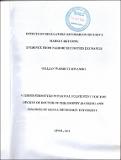| dc.description.abstract | Capital markets are key to the economic development of any economy. Most governments have invested immensely on the capital markets through regulation to ensure that the investors are protected and making the market more efficient. The responsibility of regulation of the capital market in Kenya rests with the Capital Market Authority. Since its establishment the authority has created a regulatory framework that is aimed at creating orderliness, fairness and efficiency in the capital market. This study aims at examining the effect of reforms, guidelines and regulations enacted by the capital market authority on stock market returns. This was achieved through carrying out an event study methodology on specific regulation independently. The causal research design was used on each event to find out whether there was any significant difference between pre and post regulation by observing the behaviour of abnormal returns and stock returns volatility. Data was collected from a sample of 39 companies out a population of 55 companies which traded continuously from 1998 to 2010. NSE and stock returns were subjected to market model to determine alpha and beta to calculate abnormal returns. The GARCH model was used to find the significant difference between the pre and post regulation through stock market volatility. The study results indicate that each regulation analysed had evidence of abnormal returns that accumulated slowly over the event period for each of the regulations under analysis. The analysis of regulation on insider trading shows high level of abnormal returns ranging from O to 8. The analysis of the information disclosure regulation, corporate governance and licensing requirements regulations indicates reduced abnormal returns ranging from -02 to 0.7,-0.4-0.6 and -0.4-0.06 respectively. The regulation on the Central Depositories (operational rules) had abnormal returns ranging from -1 to 4 but much was after the regulation was enacted. This could be attributed to the December 2002 general election which constituted the pre regulation period. All regulation indicated reduced volatility during the post regulation measured using the GARCH model. This is an indication of the positive effects of the regulation on Stock returns. The volatility of the mean, standard deviation and variance indicates that the market efficiency has improved as new regulations were being enacted by CMA. Each regulation created shock in volatility of the stock returns which was not persistent over time. The results indicate that investors viewed the regulation as good news to the market. There was anticipation among the investors before each regulation was enacted by CMA as reflected by stock volatility during the pre -regulation period. The study concludes that regulation of the capital market bring about efficiency through reduced volatility and reduced abnormal returns as successive regulations are enacted by the government. These results create attention to policy makers on the implementation of reforms, regulation and guidelines targeting market operations and institutional development in Kenya. | en_US |

